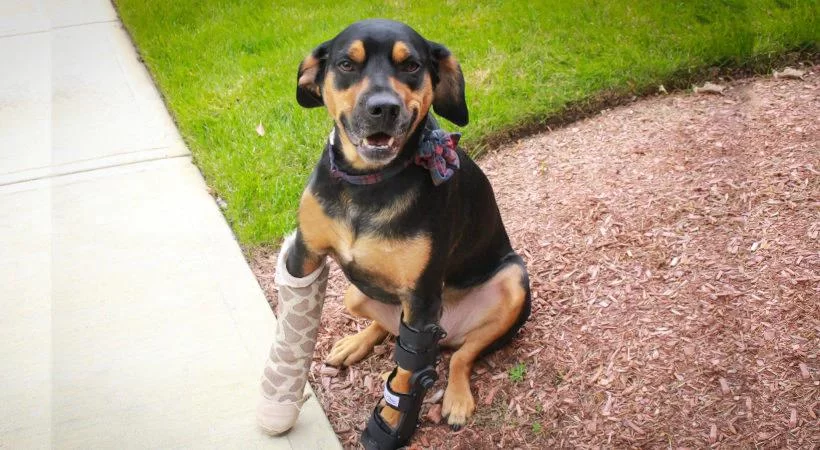How to Care for a Dog with a Broken Leg: A Complete Guide
- Understanding a Dog’s Broken Leg
- Signs and Symptoms of a Broken Leg in Dogs
- Immediate Care for a Dog with a Broken Leg
- Veterinary Care and Treatment Options
- Post-Injury Recovery Tips
- Real-Life Examples of Dogs with Broken Legs
- Consult Hidden Brook Veterinary for Expert Help
Understanding a Dog’s Broken Leg
A broken leg in a dog is a serious injury that requires prompt attention. Dogs can break their legs in many ways, from accidents like car collisions to falls or even traumatic injuries caused by falls from heights or rough play. Understanding the type of fracture your dog has is crucial to ensuring they get the right care and treatment. There are different types of fractures, such as simple fractures, compound fractures, and comminuted fractures, each requiring specific treatment protocols.
Signs and Symptoms of a Broken Leg in Dogs
Identifying a broken leg in your dog can be challenging, especially since dogs often try to hide pain. Here are some common signs that your dog may have a broken leg:
1. Limping or Lameness
If your dog is limping or refusing to put weight on one of its legs, this could be a sign of a fracture. They may carry the leg off the ground or walk with a noticeable limp.
2. Swelling and Bruising
Swelling and bruising around the injury site are common signs of a broken leg. The area may appear swollen, warm, and possibly bruised, especially in compound fractures.
3. Whining or Vocalizing
If your dog is vocalizing more than usual, whining, or growling when you touch a specific leg, this may indicate pain or discomfort from the fracture.
4. Limited Movement
A dog with a broken leg may also limit their movement and avoid putting pressure on the injured leg. They may refuse to jump, run, or climb stairs.
Immediate Care for a Dog with a Broken Leg
When you suspect your dog has a broken leg, it’s essential to act quickly and calmly to avoid worsening the injury. Here are the first steps to take:
1. Keep Them Calm
Try to keep your dog as calm as possible. Stress can make the pain worse, and excessive movement can cause further injury. Gently restrict movement by encouraging them to lie down and stay still.
2. Immobilize the Leg
If possible, try to immobilize the broken leg. You can create a makeshift splint with soft materials like a rolled-up towel or cardboard. Avoid moving the leg too much, as this could cause further damage to the bones or soft tissues.
3. Seek Veterinary Care
It’s critical to get your dog to a veterinarian as soon as possible. A professional will examine the injury, take X-rays, and determine the best course of action for treatment. In some cases, surgery may be required.
Veterinary Care and Treatment Options
Once your dog is under the care of a veterinarian, they will assess the severity of the injury and recommend appropriate treatment. Here are the common options for treating a broken leg:
1. Cast or Splint
For less severe fractures, your veterinarian may apply a cast or splint to immobilize the leg and allow it to heal. Casts typically need to be changed periodically to ensure proper healing.
2. Surgery
For more severe fractures, surgery may be necessary. Your dog may need to undergo a procedure to insert pins, plates, or screws to stabilize the bones and promote healing. Post-surgical care will include rest, medication, and follow-up visits to monitor recovery.
3. Pain Management
Pain relief is crucial for a dog with a broken leg. Your veterinarian will prescribe pain medications to keep your pet comfortable during the healing process.
Post-Injury Recovery Tips
Once your dog has received professional treatment, the healing process begins. Here are some important recovery tips to follow:
1. Limit Activity
It’s essential to restrict your dog’s activity to avoid further strain on the injured leg. Short, controlled walks may be allowed after some healing, but no running or jumping until the vet clears it.
2. Monitor the Injury
Check the injured leg regularly for signs of infection or complications. Look for swelling, redness, or warmth around the injury, and contact your vet immediately if you notice any concerning changes.
3. Follow-Up Appointments
Make sure to attend all follow-up veterinary appointments to monitor the healing process. X-rays may be taken to ensure the bones are healing properly and that the leg is stable.
Real-Life Examples of Dogs with Broken Legs
Many dogs recover well from a broken leg with proper care. For example, Max, a 6-year-old Golden Retriever, broke his leg after jumping off a porch. After surgery and a few months of rest, Max made a full recovery and was back to his usual playful self. Similarly, Bella, a 4-year-old Boxer, suffered a fracture while playing fetch. With a cast and limited activity, she recovered in just six weeks and returned to her normal routine.












